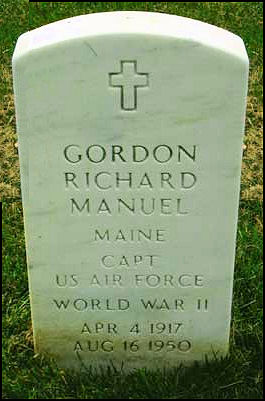Manuel was the bombardier on B-17E #41-9244, assigned to the 5th Air Force, 43rd Bombardment Group, 64th Bombardment Squadron. The plane was nicknamed 'Honi Kuu Okole', which means 'kiss my ass' in Hawaiian.
In the early morning hours of May 21, 1943 the plane took off from Dobodura Airfield in Papua New Guinea to bomb Vunakanau Airfield near Rabaul. before arriving at the target, however, the plane was attacked by a Japanese night fighter and seriously damaged. The pilot turned the bomber southward and ordered the crew to bail out. Manuel and two others managed to escape before the plane crashed into the ocean. The three men were not able to find each other and only Manuel was able to evade capture. His two crew mates were later executed by the Japanese.
Manuel made it to shore on New Britain Island and was able to avoid the Japanese with the help of locals. He eventually was able to join some Australian coastwatchers and other downed Allied airmen. After nearly nine months behind enemy lines he and the other airmen were rescued by the submarine USS Gato.
After the war the book ‘70,000 to 1' was published about his experiences. He was commissioned into the Air Force as a second Lieutenant and ended his service as a Captain.
Manuel was the bombardier on B-17E #41-9244, assigned to the 5th Air Force, 43rd Bombardment Group, 64th Bombardment Squadron. The plane was nicknamed 'Honi Kuu Okole', which means 'kiss my ass' in Hawaiian.
In the early morning hours of May 21, 1943 the plane took off from Dobodura Airfield in Papua New Guinea to bomb Vunakanau Airfield near Rabaul. before arriving at the target, however, the plane was attacked by a Japanese night fighter and seriously damaged. The pilot turned the bomber southward and ordered the crew to bail out. Manuel and two others managed to escape before the plane crashed into the ocean. The three men were not able to find each other and only Manuel was able to evade capture. His two crew mates were later executed by the Japanese.
Manuel made it to shore on New Britain Island and was able to avoid the Japanese with the help of locals. He eventually was able to join some Australian coastwatchers and other downed Allied airmen. After nearly nine months behind enemy lines he and the other airmen were rescued by the submarine USS Gato.
After the war the book ‘70,000 to 1' was published about his experiences. He was commissioned into the Air Force as a second Lieutenant and ended his service as a Captain.
Gravesite Details
CAPT USAF WW II
Family Members
Sponsored by Ancestry
Advertisement
Advertisement








